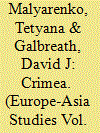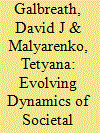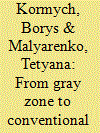| Srl | Item |
| 1 |
ID:
122780


|
|
|
|
|
| Publication |
2013.
|
| Summary/Abstract |
While the breakup of Yugoslavia produced divided loyalties and competing claims, leading to the establishment of seven separate states ending with the de facto independence of Kosovo, Crimea was a source of geopolitical instability that threatened to engulf the region in ethnic and geopolitical conflict. As a result of the negotiations during the 1990s and a de facto settlement between Slavs and the Ukrainian state, between Slavs and returning Crimean Tatars, and between Ukraine and the Russian Federation, Crimea has remained a peaceful and even increasingly wealthy area of Ukraine. Reflecting on the case of Kosovo, this paper looks at the prospect for a similar conflict in and over Crimea. Our primary question concerns the degree to which the Kosovo case sheds light on a somewhat similar case of co-ethnics, religious differences and a weakened state. We argue that the greatest source of instability lies not with ethnic claims or geopolitics, but with Ukrainian political and commercial interests that threaten the de facto settlement between the region and the centre.
|
|
|
|
|
|
|
|
|
|
|
|
|
|
|
|
| 2 |
ID:
174104


|
|
|
|
|
| Summary/Abstract |
In this essay we argue that changes in political structures in post-Soviet Ukraine have affected the potential for conflict during transition. Relying on organisational theory to determine the potential for conflict in Ukraine, we argue that this potential is structurally determined by the changing character of societal relations within and beyond Ukraine. The potential for conflict was always present in post-Soviet Ukraine, but this essay examines the facts of when, how and why conflict happened, and how it was related to weak state institutions, centre–periphery relations and an unsettled relationship with Russia. Relying on our analytical framework, we conclude that the conditions for further conflict greatly outweigh the conditions for peace.
|
|
|
|
|
|
|
|
|
|
|
|
|
|
|
|
| 3 |
ID:
192654


|
|
|
|
|
| Summary/Abstract |
A gray zone conflict that emerged after the Russian annexation of Crimea was an element of the Russian strategy of establishing and consolidating a new and more favourable internationally recognized maritime order in the Black Sea, Kerch Strait, and the Sea of Azov. Empirical data shows that Russian superiority over Ukraine and inferiority vis-a-vis the West shaped a double asymmetry of its tactics of projecting power against Ukraine while avoiding confrontation with the West. Eventually, Moscow reached a point where the gray zone tactics could not secure its objectives. The Russian invasion of Ukraine in February 2022 signalled the exhausting coercive potential of a gray zone conflict. Although, despite of transition to conventional warfare, we found continuity of ‘gray zone’ tactics of double asymmetry and denying responsibility in the Russian playbook. Hence, a possible de-escalation of the Russia – Ukraine war may likely return to a gray zone conflict.
|
|
|
|
|
|
|
|
|
|
|
|
|
|
|
|